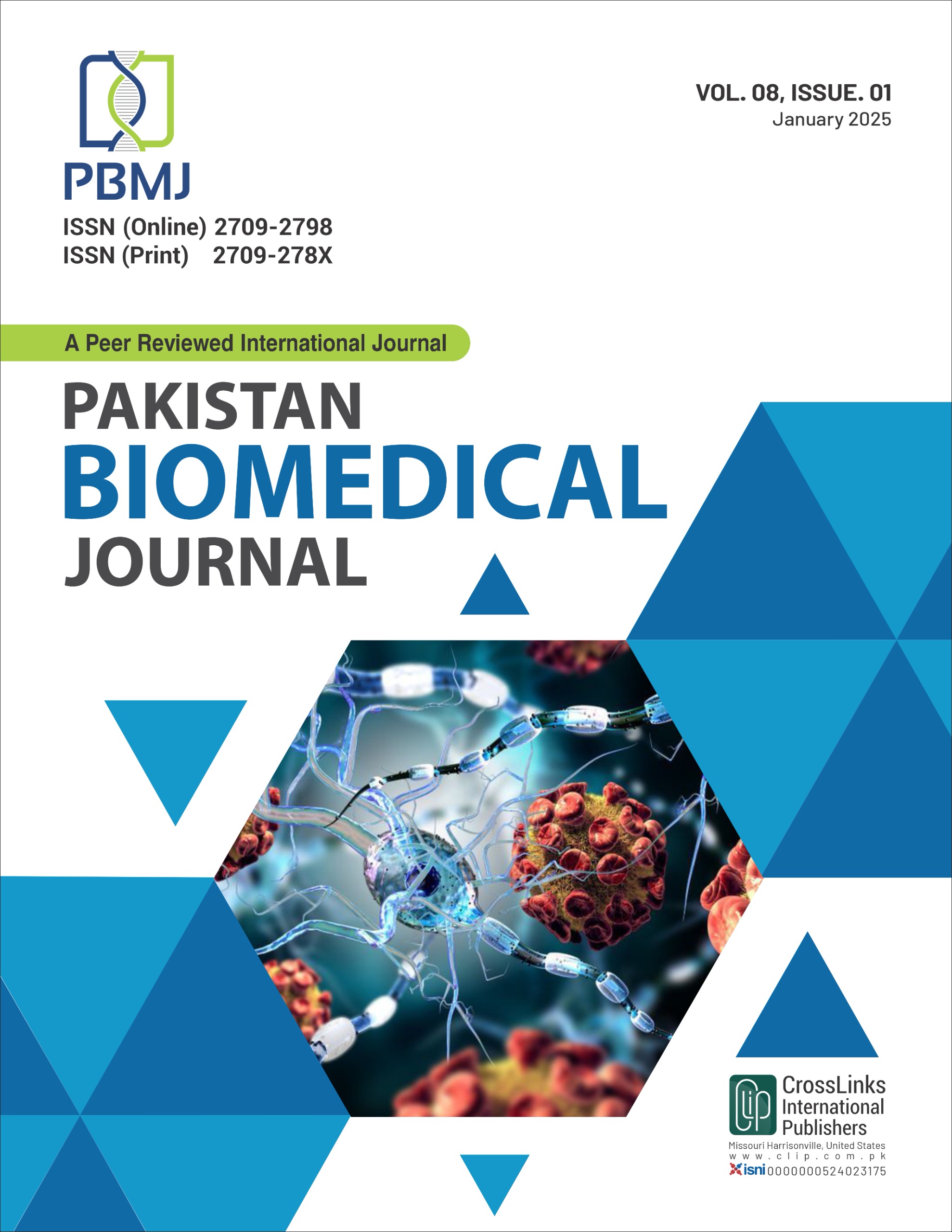The Effect of Caffeinated Coffee on Tears Secretion among Young Adults
Caffeinated Coffee and Tears Secretion
DOI:
https://doi.org/10.54393/pbmj.v8i1.1126Keywords:
Caffeinated Coffee, Nescafe, Tears Secretion, Schirmer TestAbstract
Caffeine, the most often taken psychoactive stimulant, is said to have contradictory effects on tear film dynamics. Objectives: To determine the effect of caffeinated coffee on tears secretion. Methods: Quasi experimental study was conducted from January 2023 to May 2024 at Superior University Lahore including 86 subjects of ages between 18-35 years by using convenient sampling technique. After visual acuity assessment, tear secretion of participants was checked by using Schirmer test strips. Tears secretion of all the subjects was noted before and after intake of caffeinated coffee by using Schirmer test strips. Descriptive statistics and T test was used for analysis of data by using SPSS version 25.0. Results: Before intake of coffee, 14(16.3%) showed tear secretion in the range of 5-15 mm, 21(24.4%) were in range of 16-25mm while 51(59.3%) were in the range of 26-35mm. Tear secretions after 30 minutes of coffee intake in 23(26.7%) subjects were in the range of 5-15mm, 20(23.3%) were in the range of 16-25mm while 43(50%) were in the range of 26-35mm. Similarly tear secretions after 90 minutes of coffee intake in 35(40.7%) were in the range of 5-15mm, 32(37.2%) were in the range of 16-25mm while 19(22.1%) were in the range of 26-35mm. Tear secretions before and after intake of coffee was found to be statistically significant i.e. p<0.05. Conclusion: A decreasing trend was observed in tear secretion levels at 30 and 90 minutes following the intake of caffeinated coffee and normal prior to coffee consumption
References
Wawan AH. Moderate Coffee Consumption and Cardiovascular Health. Research Horizon. 2024 Dec; 4(5): 225-32.
Viana JW, Torres RP, Bezerra TF, Nobre FW. Beneficial and Adverse Effects of Caffeine Consumption on Human Body: A Comprehensive Review. InterSciencePlace. 2021 Oct; 16(2).
Yoon JJ and Danesh-Meyer HV. Caffeine and the Eye. Survey of Ophthalmology. 2019 May; 64(3): 334-344. doi: 10.1016/j.survophthal.2018.10.005. DOI: https://doi.org/10.1016/j.survophthal.2018.10.005
Osei KA, Ovenseri-Ogbomo G, Kyei S, Ntodie M. The Effect of Caffeine on Tear Secretion. Optometry and Vision Science. 2014 Feb; 91(2): 171-177. doi: 10.1097/OPX.0000000000000129. DOI: https://doi.org/10.1097/OPX.0000000000000129
Song P, Xia W, Wang M, Chang X, Wang J, Jin S, et al. Variations of Dry Eye Disease Prevalence by Age, Sex and Geographic Characteristics in China: A Systematic Review and Meta-Analysis. Journal of Global Health. 2018 Dec; 8(2). doi: 10.7189/jogh.08.020503. DOI: https://doi.org/10.7189/jogh.08.020503
Guo LW and Akpek E. The Negative Effects of Dry Eye Disease on Quality of Life and Visual Function. Turkish Journal of Medical Sciences. 2020; 50(10): 1611-5. doi: 10.3906/sag-2002-143. DOI: https://doi.org/10.3906/sag-2002-143
Saadeh R. Caffeinated-Beverages Consumption Habits and Use Among Medical Students in North Jordan. Jordan Medical Journal. 2019 Mar; 53(1).
de Paula Lima J and Farah A. Coffee: Consumption and Health Implications. London: Royal Society of London; 2019. Chapter 14, Caffeine Consumption; 313-339. doi: 10.1039/9781788015028-00313. DOI: https://doi.org/10.1039/9781788015028-00313
Roizenblatt M, Gehlbach PL, da Silveira Saraiva V, Nakanami MH, da Cruz Noia L, Watanabe SE, et al. Weight-Adjusted Caffeine and β-Blocker Use in Novice Versus Senior Retina Surgeons: A Self-Controlled Study of Simulated Performance. Eye. 2023 Oct; 37(14): 2909-14. doi: 10.1038/s41433-023-02429-8. DOI: https://doi.org/10.1038/s41433-023-02429-8
Dong X, Li S, Sun J, Li Y, Zhang D. Association of Coffee, Decaffeinated Coffee and Caffeine Intake From Coffee With Cognitive Performance in Older Adults: National Health and Nutrition Examination Survey (NHANES) 2011-2014. Nutrients. 2020 Mar; 12(3): 840. doi: 10.3390/nu12030840. DOI: https://doi.org/10.3390/nu12030840
Sargent A, Watson J, Topoglu Y, Ye H, Suri R, Ayaz H. Impact of Tea and Coffee Consumption on Cognitive Performance: An fNIRS and EDA Study. Applied Sciences. 2020 Apr; 10(7): 2390. doi: 10.3390/app10072390. DOI: https://doi.org/10.3390/app10072390
Jiménez R, Molina R, Redondo B, Vera J. Effects of Caffeine Intake on The Biomechanical Properties of The Cornea: A Placebo-Controlled, Double-Blind, Crossover Pilot Study in Low Caffeine Consumers. Graefe's Archive for Clinical and Experimental Ophthalmology. 2020 Nov; 258: 2449-58. doi: 10.1007/s00417-020-04835-0 DOI: https://doi.org/10.1007/s00417-020-04835-0
Sharathbiddappa Bd, Prabhu A, Hanumantharaju Kn, Lokesh Ac, Gurikar C. Influence of Caffeinated Drinks on Human Health with Special Emphasis on Eye Pressure. Biochemical and Cellular Archives. 2023 Oct; 23(2). doi: 10.51470/bca.2023.23.2.795. DOI: https://doi.org/10.51470/bca.2023.23.2.795
Kim J, Aschard H, Kang JH, Lentjes MA, Do R, Wiggs JL, et al. Intraocular Pressure, Glaucoma, and Dietary Caffeine Consumption: A Gene-Diet Interaction Study from the UK Biobank. Ophthalmology. 2021 Jun; 128(6): 866-76. doi: 10.1016/j.ophtha.2020.12.009. DOI: https://doi.org/10.1016/j.ophtha.2020.12.009
Kronschläger M and Ruiss M. Coffee, Caffeine, And Delaying of Cataract Development. Coffee In Health And Disease Prevention. 2025 Jan; 413-421. doi: 10.1016/B978-0-443-13868-3.00019-3. DOI: https://doi.org/10.1016/B978-0-443-13868-3.00019-3
Redondo B, Vera J, Carreño-Rodríguez C, Molina-Romero R, Jiménez R. Acute Effects of Caffeine on Dynamic Accommodative Response and Pupil Size: A Placebo-Controlled, Double-Blind, Balanced Crossover Study. Current Eye Research. 2020 Sep; 45(9): 1074-81. doi: 10.1080/02713683.2020.1725060. DOI: https://doi.org/10.1080/02713683.2020.1725060
Singh N and Singh AK. The Association Between Caffeine Consumption and Dry Eye Disease: A Retrospective Cross-Sectional Study. Student's Journal of Health Research Africa. 2024 Sep; 5(9): 6.
Murari S, Ho A, Hayes J, Cooper S. Effects of Caffeine Intake on Visual Performance of the Eye Among Normal Healthy Adults. College of Optometry. 2018 May; 842.
Abu-Ismail L, Abuawwad MT, Taha MJ, Khamees AA, Abu Ismail DY, Sanwar M, et al. Prevalence of Dry Eye Disease Among Medical Students and Its Association with Sleep Habits, Use of Electronic Devices and Caffeine Consumption: A Cross-Sectional Questionnaire. Clinical Ophthalmology. 2023 Dec: 1013-23.
doi: 10.2147/OPTH.S397022. DOI: https://doi.org/10.2147/OPTH.S397022
Li YZ, Wang C, Peng X, Wang B, Wang JS, Xie HT, et al. Caffeine's Protective Role in Dry Eye Disease and Meibomian Gland Dysfunction: Insights from Clinical and Experimental Models. International Immunopharmacology. 2025 Jan; 146: 113863. doi: 10.1016/j.intimp.20 DOI: https://doi.org/10.1016/j.intimp.2024.113863
Downloads
Published
How to Cite
Issue
Section
License
Copyright (c) 2025 Pakistan BioMedical Journal

This work is licensed under a Creative Commons Attribution 4.0 International License.
This is an open-access journal and all the published articles / items are distributed under the terms of the Creative Commons Attribution License, which permits unrestricted use, distribution, and reproduction in any medium, provided the original author and source are credited. For comments editor@pakistanbmj.com











